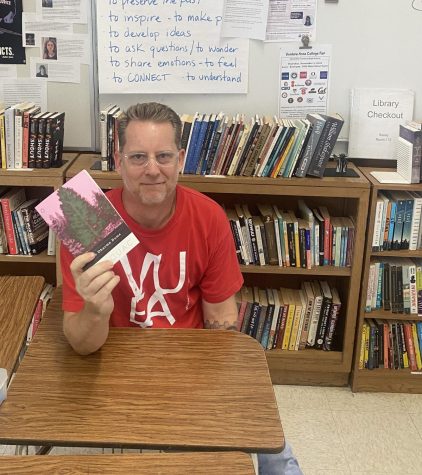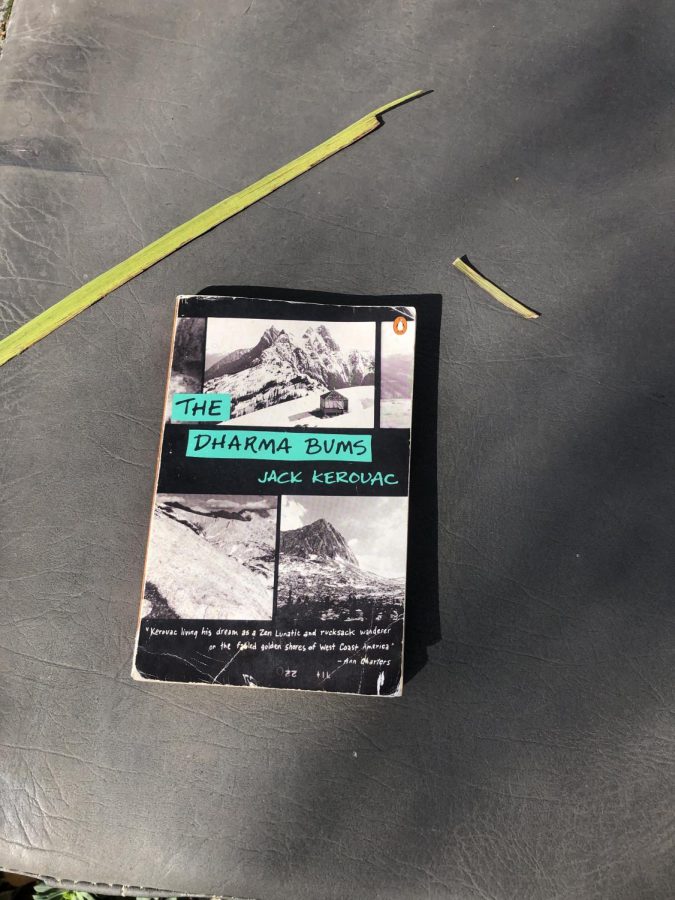Book review: “The Dharma Bums”
The copy of “The Dharma Bums” that has been passed around among Hugh Murphy, Buck Balling and Miles Newman. A classic of contemporary American literature, “The Dharma Bums” is praised for its unique stream-of-consciousness style and moving spirituality. The novel has moved and changed each of us in very different ways and permanently altered the trajectory of our lives. Photo by: Hugh Murphy
October 14, 2022
A spiritual rollercoaster through 1950s America by Jack Kerouac
“The Dharma Bums” is an embellished memoir written by Jack Kerouac and published in 1958. It was released a year after Kerouac’s novel “On the Road,” a nationwide phenomenon that inspired the Beat Generation, a literary and cultural movement that would inspire the hippie and counterculture wave of the 1960s onward. The book tells the story of Ray Smith and Japhy Ryder. Smith acts as a stand-in for Kerouac himself while Ryder is based on Gary Snyder, a poet from the Beat Generation. In the novel, Ryder embraces the Buddhist way of life and mentors Smith in the methods of Zen Buddhism.
In the first few chapters, Kerouac describes revelations of train hopping along the southern coast of California. Ray ends up in Santa Barbara and has adventures of sleeping on the beach, discussing religion with a fellow train hopper and performing in a slam poetry session in a local bar. Kerouac details the taste of the wine and the textures of clothes to convey every thought and feeling to the reader. The rest of the novella sees the pair continuing on these sorts of adventures: backpacking up Matterhorn Peak in the Sierra Nevada Mountains of California, working as fire lookouts in North Cascades National Park in Washington and three-day party binges, all the while learning about themselves and their relationship with the world.
This book resonated with us from the first page and the copy passed from person to person, each with our own interpretations and takeaways but a shared appreciation for the masterful writing and captivating philosophy. It was our introduction to the Beat movement, a cultural and literary movement focused on spontaneity and freedom, as well as the salacious and honest monologue style that Kerouac is known for. “The Dharma Bums” was our first real encounter with Buddhism and eastern philosophy as a whole, expanding our minds beyond the western ideologies so ingrained within our society. The book also pushed us to question the authority in our lives along with social norms.
Jack Gordon ‘23 said, “The book has made me rethink how materialistic the consumerist society we live in can be and the simple life that Ray Smith and Japhy Ryder both live is something that I aspire to work towards.”
English teacher Greg Raney said, “It definitely made me question existence and my existence. I felt like somebody understood me … that was pretty impactful, that encouraged me to continue [questioning society and what one has been told] and realizing that I wasn’t crazy and I wasn’t alone, so that was nice to see.”
We would strongly recommend this book to anyone looking to delve into counterculture, eastern philosophy and adventurous or exploratory writing.

Raney said, “[I’d recommend this book] for anybody who has questioned their parents, questioned their family, questioned the things they have been told for the majority of their life. This is a story about multiple somebodies questioning that and doing something about it, so if you want to do something about it and you want to feel more active and more in control, this is a good book for you.”
Gordon said, “[I would] probably recommend it to someone who is looking to introspect. [As well as] a naturalist, a person who enjoys spending time in nature or maybe they are looking to spend more time in nature and get outside [since] I think it’s inspiring.”
It is an engrossing read with twists and turns on every page. Contrasting raunchy humor with deep philosophical thought, Kerouac puts together a cohesive piece of literary magic.
Raney said, “I think it captures a certain part of America, of American history at a certain time really well, and I think it captures a moment in my life and a moment in probably a lot of other people’s lives too that just resonates and kind of inspires and I think it’s important.”
Despite the deep effects that the book had on us and the praise we have for it, it would be remiss to ignore the troubling subject matter and the controversy surrounding Kerouac’s life. There are multiple instances where women are objectified and treated with indifference. In the book, Princess is a love interest of Japhy Ryder and when she wants to learn more about Buddhism and practice it herself, Japhy and Ray scoff at her and write her off because she is a woman.
Raney said, “It’s easy to dismiss it as ‘Oh, it’s just part of that culture, part of the time period,’ which in a lot of ways it was, but I think the fact that we can look at it now in 2022 and notice those things, when you hear him use certain words or talk about women in certain ways, it should stand out to us and that is a good thing. Its an indication of where we’re at as a society, as a culture and as readers.”
Gordon said, “Clearly the book does present some sexism with characters like we see with Princess and Rosie, they’re definitely mistreated and misrepresented. It’s disappointing to see but it does demonstrate some of the thoughts that the Beat Generation writers had and obviously his abuse of women is something we don’t want to ignore but at the same time we have to enjoy his literature.”
As readers and as people we must recognize the flaws of the work and of the author while simultaneously appreciating the value of the writing along with the messages and themes conveyed. “The Dharma Bums” by Jack Kerouac is a flawed yet essential masterpiece of 20th century American literature that leaves the reader more conscious of the world around them and is a must read for those questioning their place in society.










![Lindsay Guzik, new assistant principal said, "I am settling in [at VHS] pretty well. I know a lot of the students, so that makes it a little bit easier coming from Cabrillo, and it's been nice to see them all grown up." Photo by: Abraham Kassa](https://thecougarpress.org/wp-content/uploads/2025/09/IMG_9728-300x200.jpg)

Jack Gordon • Oct 18, 2022 at 12:52 am
Excellently voiced review, gentlemen. The point of the westernized counter culture Kerouac presents is one that is somewhat forgotten if not consciously thought of or observed, and your guys’ remarks on the subject were spot on. Mr. Raney’s commentary about “Dharma Bums” almost being a book of self-help to an individual who feels lost in a society was extremely relatable and sums up the book perfectly. You guys really hit all the greatest points and I must agree, I would totally recommend this book to someone else, for it is now one of my favorites of all time. Great review, guys.
Book Guy • Oct 17, 2022 at 6:00 pm
More like dharma buns. 0/10
John Doe • Oct 15, 2022 at 1:43 pm
I am pleased that the counterculture brought an influx of Buddhist thought into the United States, but I am quite cautious of what this form of Buddhism took in the States.
Frankly– it’s a perversion of Buddhism. This form of Western Buddhism emerged from the counterculture and with it came misconceptions of being a Buddhist.
The Buddhist from Asia (from which, the religion originated from) clearly states that there ought to be sexual restraint, condemnation of drugs (especially recreational), alcohol, and filial piety (or familial respect).
In regards to the counterculture of the 1960s, the hippies that were common throughout the era had a certain knack for recreational psychedelics, rarely took sexual restraint, and commonly disobeyed parental guidance (viewing it as oppression). They were also the same people claiming to be part of the Buddhist religion.
What the Western Buddhist misunderstood is that their form of Buddhism has close to nothing to do with the actual religion they are claiming to follow. They cherry-pick certain parts of Buddhism they like and disregard the rest.
And it should be noted that–yes, while Buddhism is fluid and dynamic in terms of its spiritual teachings it still has rules and guidelines that have been laid down for monastics and laymen to follow.
It is good that the Western Buddhist believed in non-violence, the value of the human, and the transient nature of material. The counterculture is what I am blaming here– it has elements of degrading progressiveness that unfortunately are conflated into this form of Buddhism. This philosophy and its adherents have no place in Buddhism and I feel especially compelled to write this reply coming from a Buddhist.